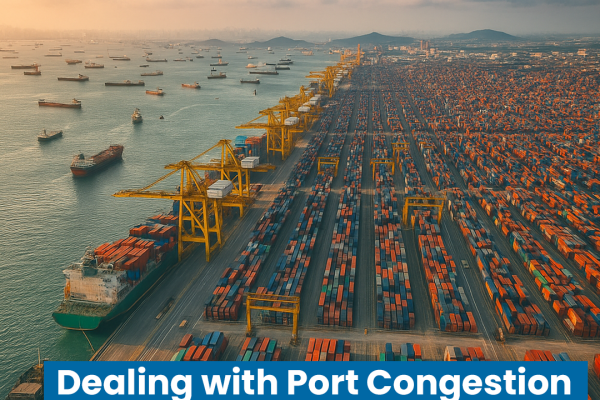Port congestion occurs when the number of vessels and volume of freight exceeds the handling capacity at any given container shipping terminal. Stress points we are seeing right now are at the major ports in Europe, such as Rotterdam and Hamburg, and also in SE Asia, including Shanghai and Singapore. The effects will be felt whether these are either your port of origin, or transhipment points.
The resultant bottlenecks lead to delays and operational inefficiencies, as well as surcharges. Container ships often have to anchor outside the port or drift in designated areas until space becomes available. Delays then lead to too many vessels arriving in port at once, known as ‘vessel bunching,’ exacerbating the congestion and further disrupting schedules.
Port congestion can be caused by a number of factors, including poor infrastructure, limited storage capacity, labour disputes, or equipment breakdowns. This is being evidenced right now across Europe, where severe congestion is crippling ports due to a combination of new alliance vessel deployments, industrial action, adverse weather conditions, and overcrowded container yards.
Some of the most troubled locations are in Rotterdam, Antwerp, Hamburg, Barcelona and Valencia. And it is not limited to northern Europe – in the Mediterranean, Piraeus is experiencing berth wait times of 4 to 6 days. Italian ports such as Genoa and La Spezia are also seeing average delays of around 4 days.
Furthermore, Europe is experiencing disruptions in inland transport. Low Rhine River levels, rail closures, and construction projects are causing bottlenecks for inland barge and rail transport.
The trade war between the US and China poses unique challenges for Southeast Asian ports, as traditional risk models must now adapt to the unpredictability of trade responses.
Reports indicate waiting times of up to 7 days to berth in Singapore, with long queues of vessels. This is due not only to Red Sea diversions, but also ships skipping other ports like Port Klang. Some shipping lines are omitting Singapore calls, which can cause further delays at downstream ports.
Container shortages present additional stress to the system. The congestion is contributing to tighter container availability, especially in major Chinese ports like Shanghai and Ningbo.
Congestion Surcharges
Containerlines can apply a Congestion Surcharge to cover the additional costs incurred due to delays and increased operational complications at overcrowded ports. This varies according to the carrier and the route they service, but generally starts at several hundred U.S. dollars for a 20’ container, to over US$1,000 for a 40’. Call us to determine the figures that apply to your particular shipment.
Strategies for Coping with Port Congestion
There are several strategies that can help keep your cargo moving and minimise the impact of port congestion on your operations
Diversification of ports: If one port is chronically congested, alternative gateways that may have more capacity should be explored. Colless Young will work with you to make the correct decision.
Build in buffers: Importers should pad their shipping timelines to account for potential delays and, where possible, factor in appropriate margins to their landed cost estimates.
Staying informed: We keep a close eye on port conditions and utilise tools like real-time freight rate tracking and predictive analytics, to provide you with the most up-to-date information on congestion chokepoints around the world.
At Colless Young, we know that port congestion is just one of the many challenges shippers face in today’s global freight environment. Rely on our expertise and let us work with you to craft proactive strategies.
If you have any questions about port congestion and how it affects your cargo, give us a call at Colless Young. Talk to Andrew, Tel: +61 7 3890 0800 email enq@collessyoung.com.au

